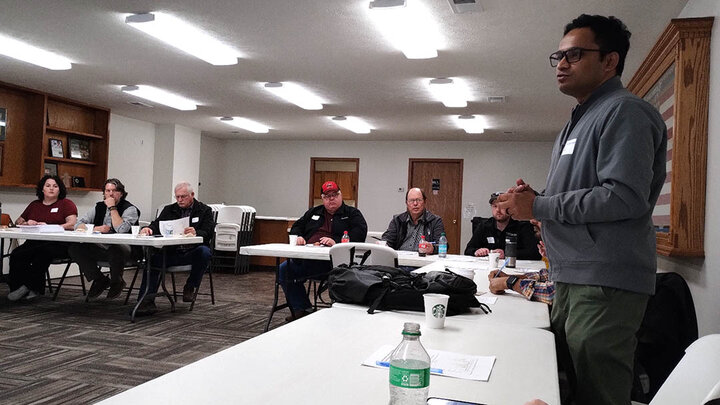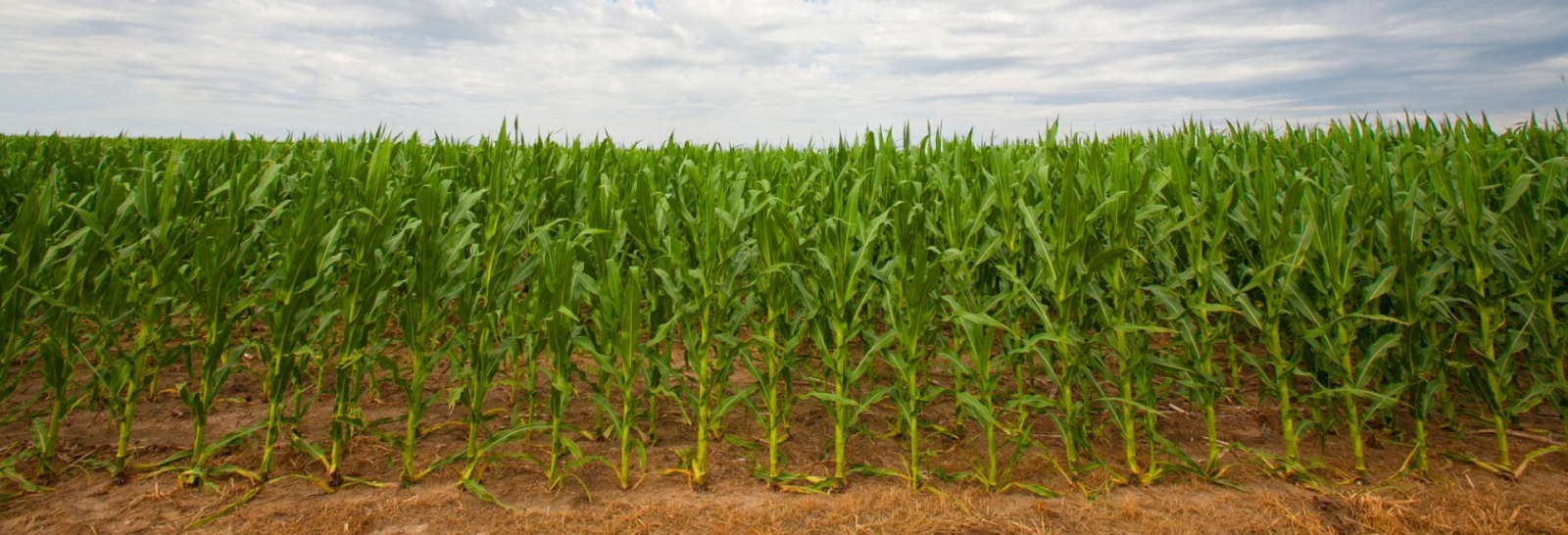Article Summary
Farmers, community leaders, researchers and extensionists met in March to recap successes of the Shell Creek Watershed Improvement Group (SCWIG). SCWIG has been active for 25-plus years to promote best management practices to improve water quality and reduce flood impacts. The group includes farmers and community leaders who worked with the Department of Environment and Environment (NDEE), Lower Platte North Natural Resources District, several local schools, and other groups and organizations, incrementally growing supporters and funding year over year.
Research funded by NDEE investigating land use and water impacts in the watershed over the same period finds that since the 1990s, cover cropping, no-till and reduced-tillage practices have increased significantly. Conservation efforts have contributed to reductions in turbidity, suspended solids, total phosphate, Atrazine and E.coli. The instances of extreme water flow events also decreased.
Meeting participants recognized the value that multiple participants brought to the discussions and expressed interest in future meetings, as well as developing further research projects.
A Brief History of SCWIG
Necessity often drives innovation, and that was certainly the case for the Shell Creek Watershed communities impacted by two 100-year flood events in the 1990s that brought damage and hardship. Shell Creek Watershed in northeast Nebraska spans approximately 300,000 acres, 93% of which is utilized for agriculture. A local conservationist convened a series of public meetings across Schulyer, Platte Center and Newman Grove to discuss how the watershed might be improved. The early meetings held in the fall of 1999 led to the creation of the Shell Creek Watershed Improvement Group (SCWIG), who defined several goals for the group, including the coordination of efforts to reduce flooding, manage runoff, improve surface and groundwater quality, in part through education to the public and landowners.
Change was not necessarily fast but incremental with partners, funding and support growing along the way. The Shell Creek Project was funded in part by a Clean Water Act Section 319 grant through the Nebraska Department of Environment and Energy. Initial funding supported a farmer and landowner survey in 2001, which identified practical best management practices. Pheasants Forever and Lower Platte North Natural Resources District hired a part-time employee to promote conservation practices. Through more funding from the NDEE and the Nebraska Environmental Trust, educational meetings including evening “pie and ice cream” events helped spread the word about matching funds for the use of no-till, buffer strips and sewer system upgrades, amongst other practices.
Youth involvement has been an important component of the project’s success. Newman Grove Public Schools Science Department launched a long-term program to measure water quality in the watershed beginning in 2002. Several other schools, including Schulyer and Columbus Lakeview High Schools, have also engaged in sampling and research projects over the years.
In 2004, a full-time NRCS conservationist was hired to focus primarily on Shell Creek Watershed. Grant funds for conservation including the use of no-till practices continued to grow. SCWIG began its regular newsletters to landowners and farmers. Over the next 10 years, there were large increases in the use of no-till practices in the watershed, and other farms included contour and habitat buffers. Education remained a focus, including SCWIG hosting numerous field days, workshops and tours to highlight best management practices.

A milestone achievement came in 2018 when the Shell Creek was one of the first watersheds in the United States to be delisted from the U.S. Environmental Protection Agency’s Impaired Waters list for contamination from atrazine. A bank stabilization project completed in 2017 near Schuyler experienced minimal damage in the 2019 flooding, another great accomplishment compared to the damage from flooding in the 1990s. The group recognizes their persistence and relationships that have carried forward the work over the last 25 years.
Sharing Research, Celebrating Success and Considering the Future
These watershed level successes driven by persistence and partnerships lead to research questions. Leaders at NDEE hoped to better understand and quantify the results and processes behind the successes of SCWIG’s efforts. In 2021, research faculty Tirthankar Roy (UNL Department Civil and Environment Engineering) and Andrea Basche (UNL Department of Agronomy and Horticulture) began research funded by NDEE to study Shell Creek. The goal of the work was not only to understand the effects of increased conservation in Shell Creek on water quality and quantity, but also better promote SCWIG’s important efforts.
On March 11, 2025, a meeting in Lindsay, Nebraska brought together 22 landowners, extensionists, researchers from the University of Nebraska-Lincoln (UNL) and SCWIG members to share achievements and discuss the research project’s findings.
Notable results from the research shared by Graduate Research Assistant Shivendra Srivastava and Assistant Professor Tirthankar Roy included:
- Winter cover crop acreage increased in the Shell Creek Watershed from approximately an average of 4,500 acres from 1990 to 1999, to approximately an average of 11,000 acres from 2012 to 2021. This data is derived from specialized satellite imagery of tillage and crop rotation practices, going back to the early 1990s, aligning well with the beginning of SCWIG efforts.
- Further analysis of the satellite imagery found that no- and reduced-tillage acreage increased over the same time periods. Between 2014-2017 and 2018-2021, the average area under no-till increased from approximately 33,500 to just over 40,000 acres, while reduced-tillage expanded from approximately 33,000 to over 50,000 acres.
- With respect to water quality, the data analysis found decreases in the total suspended solids, turbidity and total phosphorus concentration in Shell Creek Watershed. For instance, the average total suspended solid concentration was reduced by approximately 40%, turbidity by 10% and total phosphate by 13%, from averages in 2002-2011 to the 2012-2021 period.
- Substantiating the de-listing of the watershed for Atrazine contamination, data analysis also found a decrease in its concentrations as well as in E. coli bacteria concentrations. These pollutants were important concerns in the watershed, making Shell Creek less favorable to aquatic life. Atrazine is a common herbicide utilized in corn production, also known for being a major pollutant of soil and water ecosystems (Singh et al. 2017). E.coli in waterbodies can cause a broad spectrum of human diseases (Nataro and Kaper 1998).
- Using streamflow data from the watershed, the research found that conservation efforts in the watershed decreased the number of extreme event occurrences. The exceedance values of flows for 10- and five-year return periods were calculated. In straightforward terms, these return periods explain how often, on average, an extreme event such as a flood or high-volume rainfall can happen. For instance, during a 10-year return period, a particular event has a 10% chance of happening in any given year, while a five-year return period has a 20% chance of happening in any given year. The analysis found that over the past decade, the magnitude of daily surface flow exceeded 10-year and five-year thresholds only three times, while over the entire 1991-2023 period analyzed there were 16 such events. The fact that the flow exceeded thresholds many fewer times is very positive, representing a reduction in risks for the Shell Creek communities.

‘We Are Just Too Stubborn to Quit’: Discussion of the Future
Gene Wissenburg, SCWIG member, noted during the meeting that the group has been “too stubborn to quit”, a valuable testament to the group’s persistence and plans to continue. An important element of the March 11 meeting was to discuss how a group of collaborators could support new and ongoing efforts. Participants were encouraged in small groups to answer several questions, including:
- If you were going to perfect the Shell Creek Watershed, what would be the project or practice that you would implement?
- What kind of research would you want to see to support Shell Creek Watershed in the future?
Participants noted that they hoped to see more research on technology that works in the local environment, including cover cropping into standing corn, customizing practices that are flexible year-to-year especially in less favorable conditions such as drought, combining practices on farms and split nutrient applications. Economics of best management practices was an important question raised by several groups. Participants noted that they hoped in the future to see more conclusive guidance about best practices, greater cost share options, more qualitative research, more collecting, sharing and publishing information, with one group noting that “everyone involved should have a say, with no group over the rest.” Another group noted the value of having multiple stakeholders participating in research questions and design.
Other important questions raised by the small group discussion included:
- How do management practices or the break from ‘normal production activities’ influence the health and state of the environment (soil and water health)?
- How do we afford these practices in an ever-changing market and environment?
- How do we integrate multiple production activities (cropping and livestock) to optimize profit from the land?
- I need more opportunities to ask producers of all stages in BMP involvement, what resources they need to grow and learn whether one year in or 20 years in.
A succinct comment from one group noted that there is a need for “more of these types of meetings where producers, researchers, government agencies, and educators are all talking to each other to solve common problems.”
Collective efforts to expand best management practices can result in positive outcomes, as 25-plus years of efforts in Shell Creek Watershed demonstrate. Ongoing dialogue between landowners, researchers, agencies and other conservation organizations ensures that conservation efforts remain effective and adaptable, paving the way for a more resilient agricultural landscape.
Acknowledgements
The authors would like to acknowledge Shell Creek Watershed Improvement Group members who supported the organization of the workshop, including Matt Bailey, Gene Wissenburg, Mark Seier, Carl Groteluechen, William Boss and Ray Flood, as well as NDEE staff Jessica Russell, Katie Hickle and Elbert Traylor.
References
Singh, S., Kumar, V., Chauhan, A. et al. Toxicity, degradation and analysis of the herbicide atrazine. Environ Chem Lett, 16, 211–237 (2018). https://doi.org/10.1007/s10311-017-0665-8
Nataro JP, Kaper JB. Diarrheagenic Escherichia coli. Clin Microbiol Rev, 11 (1). (1998). https://doi.org/10.1128/cmr.11.1.142

